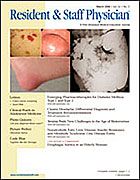Publication
Article
Resident & Staff Physician®
Cardiac-Related Syndromes that Mimic Ischemia in the Pediatric ECG
Author(s):
Frank A. Paul, DO, FACOEP,
Emergency Medicine Residency Director, Kingman Regional Medical Center, Kingman, Ariz; Eileen M. Pokriefka, DO, FAAP, Vice Chairman, Department of Pediatrics, Mount Clemens General Hospital, Mount Clemens, Mich; Craig R. Wallingford, DO, FACOFP, Program Director, Family Practice Residency, University of New England, College of Osteopathic Medicine, Biddeford, Me; Joanne Mozuras, MS, CNM, Clinical Practice, New Haven Medical Center, New Haven, Mich
CASE PRESENTATION
A 5-month-old infant presents with a history of "severe" cough, runny nose, and irritability. He has had low-to-normal weight gain with adequate feeding. The infant appears nontoxic, well hydrated, and in no acute distress. Vital signs are: heart rate, 150 beats/min; respiratory rate, 32 breaths/min; temperature 100.2?F. Physical examination shows evidence of upper respiratory infection. His skin is warm, dry, and slightly pale. Aprominent mitral regurgitation murmur is evident, but the lungs are clear to auscultation. There is no clubbing, cyanosis, jugular venous distention, or edema. A chest x-ray shows moderate cardiac enlargement but no evidence of congestive heart failure (CHF). An electrocardiogram (ECG) is obtained (Figure).
How do you interpret this ECG?
